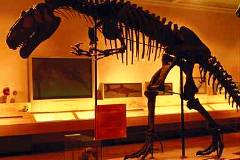2 October 1998
Look Ma No Lips But My Teeth Still Bite
 Studies by an Ohio University paleontologist suggest that contrary to popular belief, Tyrannosaurus rex probably didn't have lips and Triceratops most likely didn't have cheeks. The assertion could have implications on scientists who study these extinct animals and the toy manufacturers, movie set designers and artists whose recreations of dinosaurs now seem to be inaccurate.
Studies by an Ohio University paleontologist suggest that contrary to popular belief, Tyrannosaurus rex probably didn't have lips and Triceratops most likely didn't have cheeks. The assertion could have implications on scientists who study these extinct animals and the toy manufacturers, movie set designers and artists whose recreations of dinosaurs now seem to be inaccurate.
"I almost expect a backlash as a result of our findings. There is a sense that we're changing the way a lot of dinosaurs look," says Lawrence Witmer, an assistant professor of anatomy at Ohio University and principal investigator on a National Science Foundation project to study the soft tissues of dinosaurs.
Witmer presented his research at the annual meeting of the Society for Vertebrate Paleontology held Sept. 30 to Oct. 3 in Snowbird, Utah.
Witmer's project, which has involved high-tech scanning of dinosaur fossils and dissection of their modern-day relatives, has yielded more than just a picture of the internal construction of these animals. The work has led to what Witmer believes may be a better, more accurate way to rebuild dinosaurs using basic comparative anatomy. "When you work on extinct animals, there is a pressure and a sincere desire to know what these animals looked like," Witmer says. "We draw these pictures and they look right to us because they remind us of animals we see today.
But these pictures may be wrong."
For example, Witmer says, Triceratops and Leptoceratops, both ornithischians, have long been thought to have fleshy cheeks, which scientists believed were involved in how these plant-eaters ate. The idea that they had cheeks was based on scientists' comparison of these dinosaurs to modern-day mammals, such as sheep.
Studies of fossil remains of ornithischians suggest these dinosaurs have "features on their jaw bones that require explanation," Witmer says, describing the features as "excavated areas on the upper and lower jaws resulting in the teeth being set in from the surface of the skull." Since the presence of cheeks would explain this jaw structure, scientists' claim that ornithischians had cheeks was strengthened.
But Witmer's studies have found this comparison to be false: modern mammals with muscular cheeks do not have the same sort of excavated area on their lower and upper jaw that is found in dinosaur fossils. A more likely conclusion is that these jaw features supported an extended beak, similar to the beaks on eagles or crocodiles.
It also appears scientists have made a similar mistake with tyrannosaurs, which have been likened to modern-day lizards thought to have muscular lips. Lizards have scales that Witmer says hang down along the edges of their jaws and hide the lizards' teeth when their mouths are closed. However, this isn't necessarily so with tyrannosaurs. These dinosaurs had skin that probably extended to the margin of their jaw but didn't extend to cover their teeth.
"Lips on a tyrannosaur are important if you're making a movie or a toy for a child, but it's really not a big deal if you're trying to figure out what these animals were like," Witmer says. "With or without lips, tyrannosaur was a vicious hunter."
Take a look at a Leptoceratops
